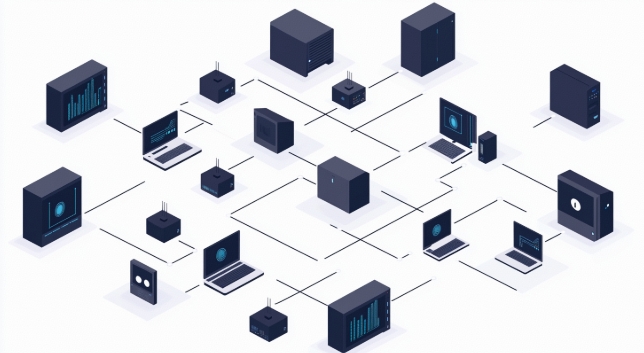Multi-User Mall Architecture and Development Strategy: How to Meet Diverse User Needs
- latest articles
- 1.DApp Development & Customization: Merging Diverse Market Needs with User Experience 2.Analysis of the Core Technical System in DApp Project Development 3.How to achieve cross-chain interoperability in Web3 projects? 4.How does the tokenization of points reconstruct the e-commerce ecosystem? 5.How to Set and Track Data Metrics for a Points Mall? 6.What is DApp Development? Core Concepts and Technical Analysis 7.Inventory of commonly used Web3 development tools and usage tips 8.Development of a Distribution System Integrated with Social E-commerce 9.Six Key Steps for Businesses to Build a Points Mall System 10.What is DApp Development? A Comprehensive Guide from Concept to Implementation
- Popular Articles
- 1.Future Trends and Technology Predictions for APP Development in 2025 2.Analysis of the DeFi Ecosystem: How Developers Can Participate in Decentralized Finance Innovation 3.From Zero to One: How PI Mall Revolutionizes the Traditional E-commerce Model 4.DAPP Development | Best Practices for Professional Customization and Rapid Launch 5.Recommended by the Web3 developer community: the most noteworthy forums and resources 6.From Cloud Computing to Computing Power Leasing: Building a Flexible and Scalable Computing Resource Platform 7.Shared Bike System APP: The Convenient Choice in the Era of Smart Travel 8.How to Develop a Successful Douyin Mini Program: Technical Architecture and Best Practices 9.How to Create a Successful Dating App: From Needs Analysis to User Experience Design 10.From Design to Development: The Complete Process of Bringing an APP Idea to Life
With the rapid development of the digital economy, e-commerce platforms are undergoing continuous structural transformations. Traditional single e-commerce platforms can no longer meet the diverse needs of users, especially the multi-user mall (Multi-user E-commerce Platform) tailored for different user roles, which has emerged in response. This type of mall not only addresses consumers' purchasing needs but also encompasses multiple user roles such as merchant onboarding, product management, and distributors, requiring complex functional demands and high-concurrency performance. This article will explore how to design and develop a multi-user mall platform to meet the needs of different users while ensuring platform stability and efficiency.
I. Overview of Multi-User Malls
1.1 What is a Multi-User Mall?
A multi-user mall refers to an e-commerce system that supports multiple types of users (such as consumers, merchants, distributors, administrators, etc.) operating on the same platform. This type of mall not only provides a shopping experience for consumers but also offers merchants a range of functions including store management, product listing, and order processing. At the same time, the platform facilitates interactions among merchants, distributors, and other parties, forming a self-sustaining transaction ecosystem.
Characteristics of multi-user malls include:
Multi-role User Support: The platform can simultaneously support users in different roles, such as consumers, merchants, distributors, and platform administrators.
Flexible Permission Management: Permission controls are designed according to different roles, ensuring users only access functions appropriate to their roles.
Complex Transaction Processes: Involving multiple stages such as product browsing, ordering, payment, distribution, and refunds, requiring the platform to handle them efficiently and ensure data consistency.

1.2 Market Demand and Value
The rise of multi-user malls is closely related to the demand for flexibility and efficiency in the e-commerce sector. Interaction between merchants and consumers on the same platform enhances transaction convenience, while the platform can leverage distributors to expand its market reach. Through appropriate product recommendations and personalized marketing, the platform can not only increase transaction volume but also improve user retention and satisfaction.
II. Architecture Design of Multi-User Malls
2.1 Core Architectural Elements
A successful multi-user mall first requires a solid technical architecture. Its architecture mainly includes the following layers:
Front-end Presentation Layer: Displays product information and promotional activities via web and mobile interfaces, allowing users to browse, place orders, make payments, etc.
Business Logic Layer: Handles core business logic such as product management, order management, and user permission management.
Data Storage Layer: Responsible for storing information about products, orders, users, etc., ensuring data security and efficient access.
Service Layer and API Interfaces: Supports seamless integration with third-party systems (such as payment platforms and logistics systems).
2.2 Front-end Presentation Layer Design
The front-end presentation layer is the main interface for user interaction with the mall platform, directly impacting the user experience. Design considerations should include:
Responsive Design: Ensures the platform adapts to different devices (PC, mobile, tablet, etc.), providing a smooth user experience regardless of the device used.
User-Friendly Navigation: Clear product categorization, intelligent search functionality, and personalized recommendations help users easily find products of interest.
Social Sharing Features: Integrate social media sharing options to enhance user engagement and platform visibility.

2.3 Business Logic Layer and User Management
The business logic layer is the core of the platform, encompassing modules such as products, orders, payments, and user permissions. The key task in designing this layer is to ensure clear functional division among different user roles, enabling efficient platform operation.
User Roles and Permission Management: Assign permissions based on different user roles (e.g., consumers can browse products and place orders; merchants can manage products, orders, and view sales data; administrators handle system maintenance and approvals).
Merchant Management System: Merchants can manage their stores, products, orders, and inventory through a backend system that is user-friendly and equipped with robust data analysis capabilities to help optimize operations.
2.4 Data Storage Layer
The data storage layer is the "heart" of the mall, handling vast amounts of product information, order data, and user data. Design considerations include:
Database Selection: Choose appropriate database types based on needs, such as relational databases (MySQL, PostgreSQL) or NoSQL databases (MongoDB, Cassandra). Relational databases are suitable for structured data, while NoSQL is ideal for high concurrency and massive data storage.
Data Redundancy and Backup: Implement measures like multi-location backups and data redundancy to prevent data loss. Distributed databases can ensure high availability.
Data Analysis and Personalized Recommendations: Analyze user behavior data to generate personalized product recommendations, enhancing user retention and platform conversion rates.
2.5 Service Layer and API Interfaces
The service layer acts as a bridge for the mall to connect with external systems. To enhance functionality and flexibility, integration with third-party platforms is often necessary.
Payment System Integration: Integrate mainstream payment methods like Alipay and WeChat Pay via APIs to ensure smooth and secure payment processes.
Logistics System Integration: Connect with logistics companies (e.g., SF Express, JD Logistics) to enable real-time logistics tracking.
Third-Party Tools: Incorporate tools such as SMS verification, email notifications, and user review systems to enhance platform functionality.
III. Development Strategies and Implementation
3.1 Flexible Permission Management
One of the core aspects of a multi-user mall is flexible permission management. During development, different access permissions must be set based on user roles. For example, consumers can only browse products and place orders; merchants can manage products and view sales data; administrators have the authority to manage platform content. Fine-grained permission division prevents conflicts between different users, ensuring platform security and stability.
3.2 High Availability and High Concurrency Handling
As the number of platform users and transaction volume increases, high concurrency and high availability become critical in architectural design. Strategies to handle large-scale user access include:
Load Balancing: Distribute user requests across different servers using load balancing technology to avoid single points of failure.
Distributed Architecture: Use distributed technology to ensure high availability of data and services, allowing dynamic scaling as needed.
Caching Mechanisms: Accelerate data access and reduce database pressure through caching (e.g., Redis, Memcached).

3.3 Data Security and Privacy Protection
E-commerce platforms handle large amounts of sensitive information, such as personal user data and transaction records. Therefore, protecting data security and user privacy is crucial. Common security strategies include:
SSL Encryption: Encrypt all transmitted data to prevent interception during transmission.
Identity Authentication and Authorization: Use technologies like OAuth and JWT for identity authentication, ensuring only authorized users can access sensitive data.
Security Protection Measures: Strengthen firewall settings and use intrusion detection systems (IDS) to protect the platform from attacks.
IV. Conclusion
With the rapid development of the e-commerce industry, multi-user malls have become an indispensable bridge between merchants and consumers. Designing and developing an efficient, stable platform that meets the diverse needs of users is a critical challenge for every e-commerce developer. Through flexible permission management, scientific architectural design, efficient data processing, and stringent security measures, multi-user malls can not only provide users with a better shopping experience but also create greater business value for merchants. As technology continues to evolve, future multi-user malls will become more intelligent and personalized, offering superior services to users worldwide.
-

How does the tokenization of points reconstruct the e-commerce ecosystem?
With the continuous advancement of internet technology and the gradual prolifera···
-

How to Set and Track Data Metrics for a Points Mall?
With the rapid development of the e-commerce industry, points malls, as a common···
-

Development of a Distribution System Integrated with Social E-commerce
With the rapid development of internet technology, the e-commerce industry has e···

 Blockchain
Blockchain










